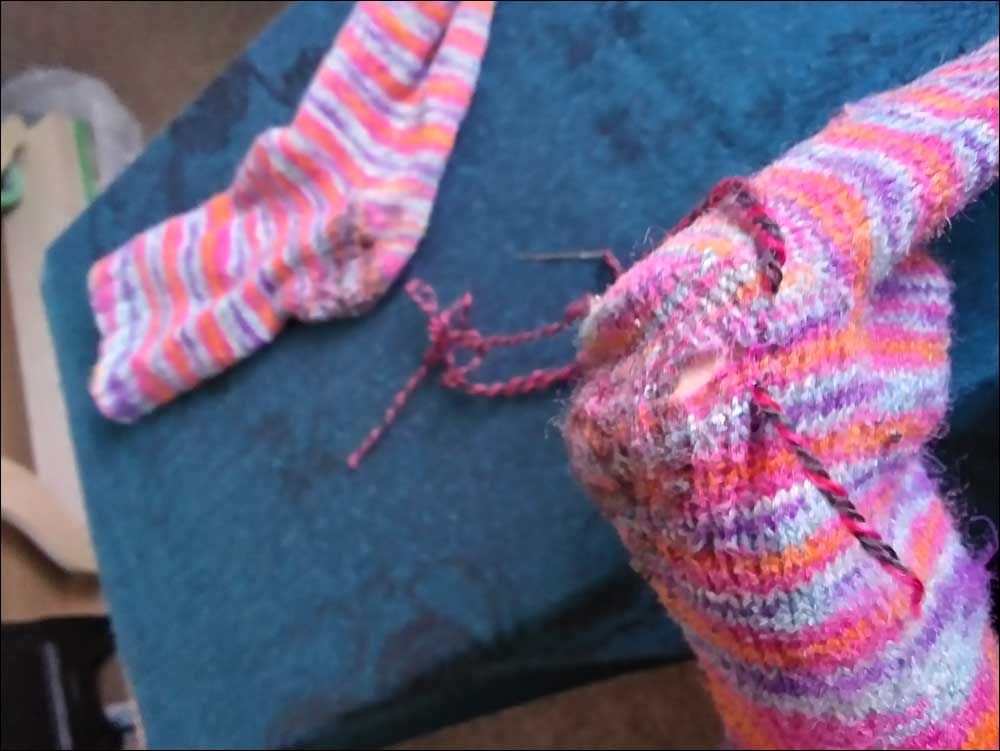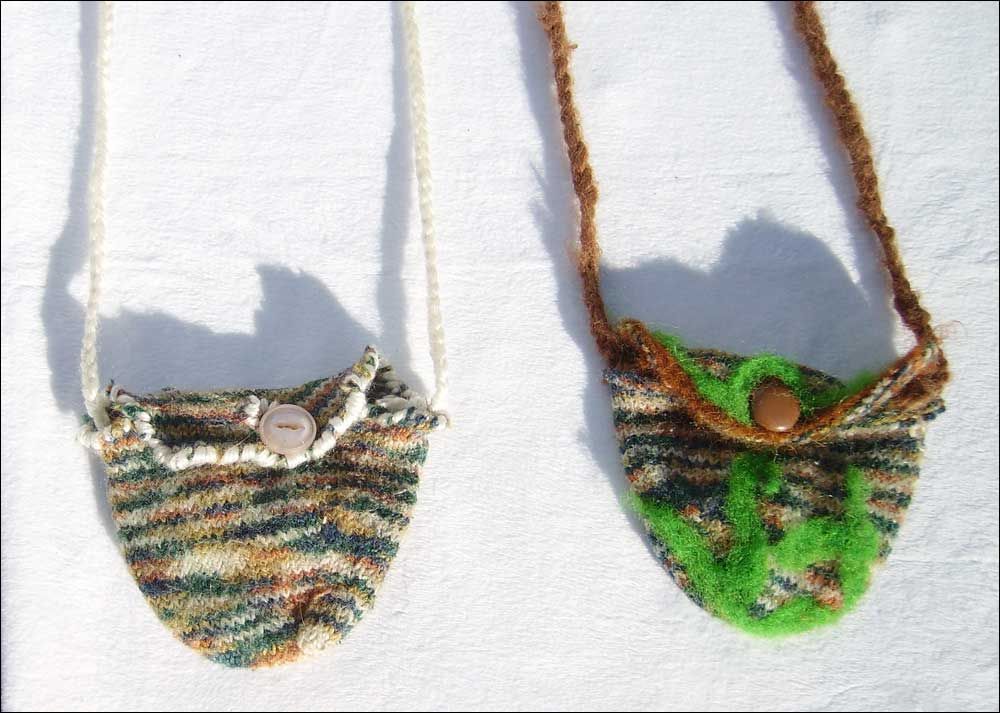Mending and Upcycling Wool Socks
(Admin: I don't know about you, but socks are one of the things I spend money on for quality because I work (or did work for thirty years) in manufacturing on concrete floors. Tired and hurting feet will make your day go bad every time. Unfortunately they get holes in them and to my embarrassment, I often just toss them, when I should be repairing them. Green Wizard pygmycory has a quite novel solution for the problem and sent me this tutorial to post. Enjoy.)

(Photo by pygmycory)
Mending and Upcycling Wool Socks
by pygmycory
Wool socks are lovely, especially handknit ones in pretty colors. However, they don’t last forever, take a while to make, and are expensive to buy. So, what do you do when your favorite pair of socks develops a hole in the toe, or goes thin at the heel? Or when you’ve mended them so many times they no longer resemble socks?
Fortunately, you can mend wool socks easily and quickly by darning, and when they can be darned no more, you can often make them into other things.
Darning and Mending
Darning is a form of weaving, using the remaining structure of the sock as a scaffold for your darning needle and the wool yarn it brings with it. To darn something, you will need a darning needle and sock yarn. In a pinch, you can use embroidery floss or a different thickness of yarn, but they won’t work as well, or look as good.
Darning can be very inconspicuous if you use a similarly-colored yarn to the sock. If you don’t have a similar color, you will end up with the darn being visible as a differently-colored patch. Depending on the color, the sock, and your tastes, you may consider this either a bug or a feature. I tend to shrug and use whatever color sock yarn I have available.
You are going to be weaving the yarn in and out through the strands of yarn present in the sock. Go over one piece of yarn, and under the next, over and under, over and under. Go from the top of the thin part of the sock, to a little beyond the bottom. Then do the same thing at right angles to your previous weaving.
Make sure that your weaving covers any small holes. Don’t try pull the hole closed with the yarn, especially if it’s a larger hole – this will distort the shape of the sock.
More generally, you don’t want to pull the yarn too tight when darning. This will make the darned area of the sock stiff, a bit smaller than the original, and the sock potentially uncomfortable. That’s what happened the first time I darned a sock. Try to match the undamaged fabric as best you can for flexibility.
The nice thing about working with wool is that it tends to stick to itself with wear, and felt very slightly. This tends to hold the fabric of the sock together even if your mending is imperfect.
I suggest looking at Youtube videos if you’ve never darned a sock before. That will be a lot more helpful to you than a written explanation, and there are plenty to pick from.
A darning needle is a large, blunt-ended needle with a big eye. The blunt end works well for weaving the yarn in and out between the yarn in the sock, and makes it easier not to split that yarn and end up trying to drag needle and yarn through another piece of yarn. It also makes it less painful when you stab yourself, which is nice. The large eye is important because you’re threading it with yarn, not thread, and you have to be able to get the yarn through the eye.
People who do a lot of darning often use a mushroom. A mushroom is a mushroom-shaped piece of wood. You stick the sock on it, and it holds the sock in the right shape so you can easily weave the needle in and out. I don’t have a mushroom. I use the fist of my left hand, and pretend it is a mushroom. I find that this works out well enough for my needs.
Sometimes, you have a sock with a tear or a large hole of an inch or more across. Fear not, you can still fix this!
Tears are not that hard to fix. You’re basically just sewing them closed. Stick the needle in on one side of the tear, pass it through to the other, and pull tight. Repeat down the entire length of the tear. I have a pair of socks where the ankle part is much too loose. I cut away the excess, then treated it like a tear and sewed it back up. It seems to have improved matters.
Large holes are harder to fix than tears or thin spots. If you were to just pull the edges of the hole together, the sock will be distorted in shape. For holes of 1cm2 or over, try weaving over the gap, and don’t pull the hole closed. When you darn in one direction, you’ll be left with a set of yarn across the hole. When you change to weaving in and out at a 90 degree angle to this, you can go under and over you new yarn you added, effectively weaving new fabric over the hole. This is best explained by seeing, so I do recommend Youtube if you want to do this and need a more detailed explanation.

(Photo by pygmycory)
There’s a lot you can do to fix damaged socks, but eventually you’ll get to the point where they’re no longer worth fixing. What then?
Upcycling
Perhaps you have socks that are misshapen by being darned too many times, perhaps you object to the many colors they now sport from previous darning efforts, perhaps that pre-shrunk yarn wasn’t and the socks now fit a doll, or perhaps the sock fabric has become so weak that it develops a new large hole every few weeks. Or the sock wool turned out to be unbearably itchy or allergy-inducing and you don’t know someone your size who’d appreciate them.
So, what do you do now? Throw them in the compost heap?
Not so fast. If you have some textile skills, consider upcycling them instead. A couple of years ago, I had a pair of socks that seemed determined to develop a new hole every few weeks. The fabric of the sock just wasn’t strong enough, despite being thick and felted-looking. I’m still not quite sure what was wrong. So I decided that since they no longer wished to be socks, I’d turn them into other things that got less wear – a pair of handwarmers.
The resulting handwarmers are warm, and also loose, since ankles are bigger than wrists. I like the looseness because I can type or play a wind instrument while wearing them, and they don’t bind round my fingers and hands and bother them. A fine success, if a little odd-looking.
In order to make these, I cut out the heels and the toes. Since the heels were where the socks were consistently going to holes, this worked well with the damage to the sock. I stuck the constantly-holy heels in the compost.
I was then left with the now-spare toes. I turned these into a pair of little key pouches on a shoulder strap. The one with the cream edges is for sale, by the way.
They are simple and easy to make. The cords are a simple braid – three sections like you’d do with hair. With this, it is important to either pick average strength or stronger yarn, or use at least two individual yarn pieces per braided section. You don’t want the cord ripping in two and dumping the bag on the ground. Ask me how I learned this...
In order to make them prettier, I decorated them. In one case, I used a contrasting cream acrylic yarn around the edges as decoration as well as reinforcement. In the other, I needlefelted unspun wool around edges and in a decorative plant pattern.
Needlefelting is a lovely way to decorate woolen items. It’s like painting with wool fluff, and it is faster to do than embroidery. Most people currently seem to be using it to make decorative sculptures. It certainly works well for that, but I like using it to decorate a plain wool item to make it truly special. I’ve also seen pairs of socks that were turned into amusing hats, though I haven’t made one myself. I have turned dead socks into mirror cleaning cloths – though those were cotton sports socks. Stick the sock on your hand, damp it down a little, and wipe the mirror with your sock-covered hand. Stick the sock in the laundry when you’re done. This is a great use for a lonely cotton sock.
All in all, there’s a lot you can do to get the most out of worn socks. Whether it’s darning a hole, or turning the sock into something new, doing something other than throwing them out can be well worth your time and effort.

(Photo by pygmycory)
Comments
gkb
Thu, 02/10/2022 - 19:20
Permalink
Needlefelting is a very good
Needlefelting is a very good description of the way I fix holes in my socks. I use a darning egg and darning needle loaded with soft, fluffy yarn of any type, polyester or wool, whatever is handy (or footy); then I crisscross any old how over the hole in a loose but space-filling manner. When I next wear the sock, the pressure of the foot packs down the loosely crissed yarn and it felts itself in place, filling the hole better than if I tried to carefully weave it. It was discovered accidentally but now I do it that way on purpose.
pygmycory
Fri, 02/11/2022 - 17:24
Permalink
Hmm. That's not a technique I
Hmm. That's not a technique I've tried - though when there's lots of strands missing I do tend to end up with a very inexact weave. And when both are wool, it does felt a bit and this helps hold the sock together. I'm not sure how well that would work if one or both are synthetic, though. Synthetic fibers aren't supposed to be able to felt.
gkb
Fri, 02/11/2022 - 19:43
Permalink
Maybe I have hot press feet?
Maybe I have hot press feet? I think it is because of the fluffiness of the yarn flattening out. If I tangle it severely enough it seems to work and even to blend into the level of the original sock.
pygmycory
Sat, 02/12/2022 - 19:18
Permalink
If it works, that's great.
If it works, that's great. Maybe I could get away with fussing a bit less.
pygmycory
Sat, 02/12/2022 - 19:19
Permalink
I tend to wear socks out much
I tend to wear socks out much faster than I'd like at the heel, so I want to make my darns as sturdy as I can.